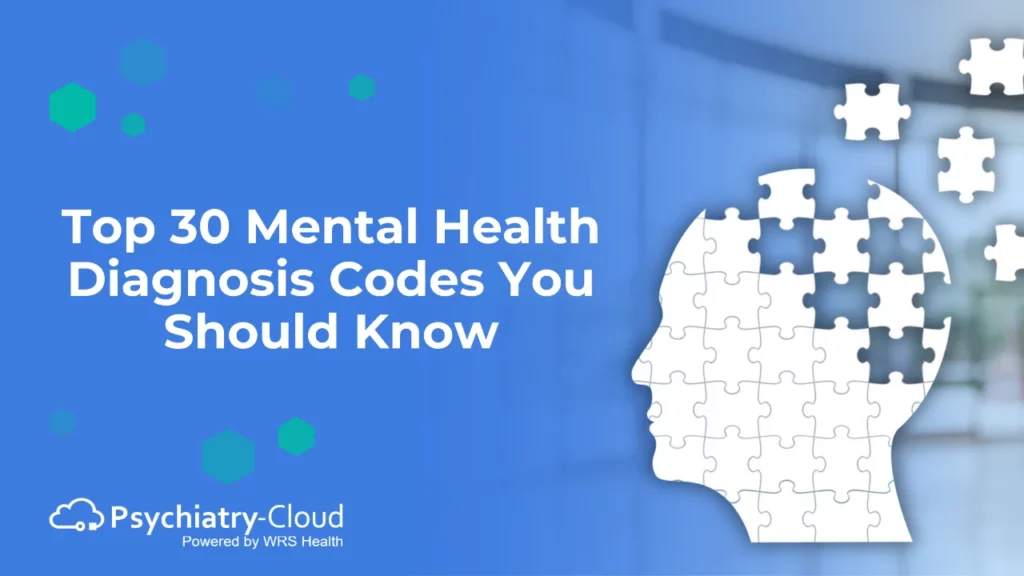Key Takeaways
- Accurate use of mental health diagnosis codes improves claim success and payment speed.
- Understanding how to link ICD-10 psychiatric disorder codes to services protects revenue.
- Know when to use procedure codes like the CPT code for couples psychotherapy to avoid underbilling.
- Learn how to prevent allowable mismatch with our comprehensive guide.
Coding errors in mental health billing don’t just delay payments—they can result in costly denials, compliance issues, and underreported care. And with increasing demand for psychiatric and therapy services, accuracy in how we report mental health diagnosis codes has never been more important.
ICD-10 codes for psychiatric disorders are used to define the patient’s clinical condition, while CPT codes tell payers what services were delivered. Get one wrong, and you may be facing rework, revenue loss, or even audit risk.
Below, we outline the top 30 mental health ICD-10 diagnosis codes, along with guidance on linking them to CPT services, including family and couples psychotherapy.
Table of Contents
Mood Disorders
Mood disorders are among the most frequently diagnosed mental health conditions. These codes cover depression, bipolar disorder, and other mood-related conditions that affect daily functioning. Billing accuracy is important, as mood disorder claims are frequently scrutinized for severity, frequency, and documented progress.
- F32.9 – Major depressive disorder, single episode, unspecified: Used when the patient presents with depressive symptoms but the severity and specific characteristics haven’t been fully assessed.
- F33.1 – Major depressive disorder, recurrent, moderate: Used for patients with repeated depressive episodes that are moderate in intensity.
- F34.1 – Dysthymic disorder: Chronic, low-grade depressive symptoms lasting two years or more.
- F32.5 – Major depressive disorder, single episode, in partial remission: Used to document progress in therapy while still justifying continued treatment.
- F06.30 – Mood disorder due to known physiological condition, unspecified: Used when a medical illness is driving affective symptoms.
- F31.9 – Bipolar disorder, unspecified: Used when bipolar symptoms are evident but don’t fit a more specific subtype.
- F31.81 – Bipolar II disorder: Applies to patients with a history of hypomania and depression, but no full manic episodes.
Anxiety, Trauma, and Stress-Related Disorders
These codes are used to capture disorders related to anxiety, trauma, and adjustment challenges. They often involve symptoms like worry, fear, avoidance, and heightened stress responses. Claims using these codes are supported by DSM-5 criteria and tied to time-based psychotherapy CPT codes. Insurance payers often require proof of clinical necessity for extended sessions or long-term treatment.
- F41.1 – Generalized anxiety disorder: Applied to patients with persistent, excessive anxiety and worry about various domains of life.
- F43.23 – Adjustment disorder with mixed anxiety and depressed mood: Appropriate for patients whose symptoms follow a life stressor but do not meet criteria for MDD or GAD.
- F43.10 – Post-traumatic stress disorder (PTSD), unspecified: Applicable for patients experiencing trauma-related symptoms without a confirmed duration or severity.
- F43.8 – Other reactions to severe stress: Useful in cases of trauma or crisis that don’t meet PTSD criteria.
- F40.10 – Social phobia, unspecified: Used when a patient avoids social situations due to fear of scrutiny or embarrassment.
Substance Use and Related Disorders
Substance use disorders impact millions of patients and range from nicotine dependence to complex cases involving multiple substances. These codes help identify patterns of misuse and dependency. Billing for substance use disorders may require additional modifiers or specific CPT codes tied to group therapy, assessment, or detox support. Documenting both the behavioral diagnosis and treatment plan is important to avoid denials.
- F10.20 – Alcohol dependence, uncomplicated: Used when the patient meets DSM-5 criteria for alcohol dependence without associated complications.
- F15.10 – Stimulant use disorder, uncomplicated: Used when stimulant misuse is diagnosed without accompanying intoxication or withdrawal symptoms.
- F17.200 – Nicotine dependence, unspecified, uncomplicated: Used when smoking behavior meets DSM-5 criteria without withdrawal.
- F19.20 – Other psychoactive substance dependence, uncomplicated: Applied to patients using substances not otherwise specified, like inhalants or hallucinogens.
Psychotic and Neurodevelopmental Disorders
These diagnoses include conditions such as schizophrenia, schizoaffective disorder, and autism spectrum disorder. They often require long-term care and are essential to identify accurately for treatment planning.
- F25.9 – Schizoaffective disorder, unspecified: Used when a patient shows symptoms of both schizophrenia and mood disorder.
- F20.9 – Schizophrenia, unspecified: Common in serious mental illness treatment settings; used when symptoms fit schizophrenia but subtype isn’t specified.
- F84.0 – Autistic disorder: Diagnostic code applied in cases of autism spectrum disorder with significant language or social impairment.
Personality Disorders
Personality disorders reflect enduring behavioral and emotional patterns that affect relationships and self-image. Proper documentation is key for therapeutic interventions and coverage.
- F60.3 – Borderline personality disorder: Used for patients with a consistent pattern of unstable relationships, mood swings, and impulsivity.
- F60.81 – Narcissistic personality disorder: Used for patients with pervasive patterns of grandiosity, need for admiration, and lack of empathy.
Need a billing service that gets you paid right the first time, every time? Schedule a demo with our team.
Somatic and Behavioral Disorders
When psychological conditions manifest physically or through compulsive behaviors, these codes apply. They capture patterns that don’t fall neatly into mood or anxiety categories but still require behavioral healthcare. These diagnoses often intersect with medical billing codes. Providers must indicate specifically when care is behavioral in nature to avoid bundling or to trigger medical claim denials.
- F45.0 – Somatization disorder: Applied when physical symptoms appear without identifiable medical cause, often requiring a behavioral health approach.
- F45.42 – Pain disorder exclusively related to psychological factors: Applied when chronic pain has no medical explanation and psychological support is central.
- F42 – Obsessive-compulsive disorder: Used when a patient exhibits persistent intrusive thoughts (obsessions) and/or repetitive behaviors (compulsions).
- F51.01 – Primary insomnia: Used when sleep issues are not attributable to another disorder or substance.
- F63.3 – Trichotillomania (hair-pulling disorder): A compulsive condition often treated through CBT or DBT.
Childhood-Onset Disorders
These codes are reserved for conditions that begin in childhood or adolescence, including ADHD and separation anxiety. Early identification and coding ensure timely support and intervention. When billing for pediatric behavioral services, always link diagnosis codes to age-appropriate interventions like parent counseling, school coordination, or medication checks.
- F90.0 – Attention-deficit hyperactivity disorder, predominantly inattentive: Common in both children and adults; often paired with medication management services.
- F93.0 – Separation anxiety disorder of childhood: Typically seen in younger patients experiencing extreme distress when separated from caregivers.
- F98.8 – Other specified behavioral and emotional disorders with onset usually occurring in childhood and adolescence: A catch-all code for non-categorized behaviors that still require intervention.
CPT Code for Couples Psychotherapy
- 90847 – Family psychotherapy (conjoint psychotherapy) with patient present: This CPT code for couples psychotherapy is often misunderstood. It should be used when therapy involves the patient and one or more family members, including partners or spouses, with the focus on the patient’s mental health.
Avoid mislabeling this service as individual therapy or using 90846 (without patient present) unless the session truly meets that criteria.
Mental Health Documentation Tips
Good documentation is the foundation of compliant billing. Keep these tips in mind:
- Link every ICD-10 code to a medically necessary service.
- Include symptom duration, severity, and DSM-5 criteria where applicable.
- Document patient engagement, treatment response, and care plan changes.
- For procedures like couples therapy, indicate the therapeutic goals, participants, and focus of care.
- Use standardized templates to reduce error and improve consistency across sessions.
3 Common Coding Errors in Behavioral Health
Missing Specificity on Diagnosis
Using “unspecified” codes (like F32.9) too often can trigger payer pushback. When possible, code to the highest specificity available. Failure to update codes over time can also result in denied follow-up claims. Reassess and document progress periodically.
Incorrect Use of Psychotherapy CPT Codes
Billing for individual therapy (90834) when family members are present and actively involved may be flagged in audits. Use 90847 when the therapeutic focus involves the family system.
Lack of Justification for Continued Care
Especially for long-term therapy, you must document progress, goals, and rationale for ongoing sessions to support medical necessity.

Stay Informed, Stay Paid
Effective mental health billing goes beyond compliance to help patients get the care they need without interruption. By understanding the most used ICD-10 and CPT codes and how to support them in your documentation, your practice can reduce denials and maintain a healthy revenue stream.
FAQs: Mental Health Coding
Can I use the same ICD-10 code for multiple therapy sessions?
Yes, as long as the diagnosis remains clinically relevant and you continue to document symptoms, treatment goals, and progress.
What’s the difference between 90834 and 90847?
90834 is for individual therapy, while 90847 is for family or couples therapy with the patient present. Use the correct code based on session participants and focus.
Do payers accept unspecified diagnosis codes like F32.9?
Some do, but frequent use can lead to denials or requests for more documentation. Always code to the highest specificity when possible.











